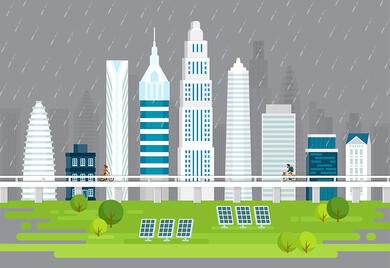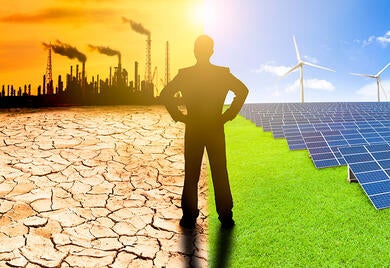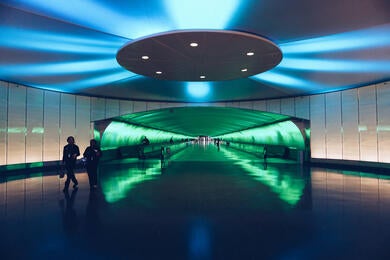Science Dyes in Green Honduras' Textile Industry
A leading company in the sector adopted a decarbonization strategy to reduce its emissions and demonstrate that sustainability and profitability can go hand in hand.

Four challenges facing the buildings of the future
In the 1960s, the Jetsons showed us a futuristic city in which pollution and the use of non-renewable resources did not exist. Twenty years later, when we had already begun to hear about environmental problems, Blade Runner showed us a more pessimistic vision of 2019: a city with countless skyscrapers, over-population, and extremely high pollution levels. Today we already have much of the Jetson’s smart technology, but sustainable buildings are needed to avoid Ridley Scott’s dystopian city. In 2016, the New Climate Economy determined that the only way to grow in the future and address the current gap is with sustainable infrastructure. According to the Inter-American Development Bank (IDB) and Mercer study “Crossing the Bridge to Sustainable Infrastructure Investing. Exploring Ways to Make it Across,” the ability to develop buildings of this kind depends on overcoming at least four key challenges: 1. Lack of familiarity What is sustainable infrastructure? Many investors still lack the information they need to clearly identify what it is and what it is not, and to identify the nature of the business opportunity. This makes it difficult to increase this type of construction. Sustainable infrastructure is planned, constructed, and operated to comply with changing governance, social, environmental, economic, and financial standards over time. For this reason, the role of multilateral and governmental organizations is to educate, inform, and provide appropriate financial products, in order to adapt current businesses to a climate change resilient economy with low carbon emissions. 2. Limited standardization of tools and approaches As this is a megatrend in full swing, there is excessive fragmentation in sustainability standards, principles, and initiatives. In addition, there is a lack of adequate information available on what the environmental, social, and governance criteria are for companies not listed in their respective securities markets, making it difficult for investors to identify which projects are sustainable. In addition, the lack of information increases transaction costs. For this reason, the IDB Group is developing and promoting the adoption of harmonized principles and working with investors to facilitate discussions regarding currently existing barriers to sustainable infrastructure. The objective is to generate useful solutions with innovative financial instruments in local markets and public-private partnerships and concessions that facilitate private sector participation. [clickToTweet tweet="US$6 trillion investment in sustainable infrastructure per year requires #Latam and the #Caribbean" quote="US$6 trillion investment in sustainable infrastructure per year requires Latin America and the Caribbean" theme="style1"] 3. Lack of coordinated policy Another fundamental point is to have consistent regulations and a commitment to comply with them throughout the region and in all sectors. Following guidelines like the Paris Agreement and the United Nations Sustainable Development Goals is key to maintaining investors’ interest in measures such as the adoption of clean energy. For Latin America and the Caribbean, it is essential to adopt instruments adapted to our reality. In this case, the IDB Group’s NDC Invest is a solution enabling countries to implement these guidelines through a simple platform for preparing sustainable and bankable project portfolios, and increasing access to concessional funds, among other benefits. 4. Lack of tools and focus on climate resilience To date, priority has not been given to how climate change adaptation should be achieved, both in terms of infrastructure and the financial tools for investing in it. However, today there are various financial tools for adapting to climate change. For example, IDB Invest (formerly known as Inter-American Investment Corporation) has mixed climate financing instruments that can be used to address these challenges and adopt climate change resilient modalities with low carbon emissions. Developing the construction of the future requires investing at least US$6 trillion per year in sustainable infrastructure for our region. This will make it possible to support the economic development of Latin America and the Caribbean, grow at the necessary pace, and prevent our cities from becoming futuristic dystopias. Subscribe to receive more content like this! [mc4wp_form]

How can we boost sustainable infrastructure investments?
Evidence is mounting that through the right mix of policies and incentives the world can significantly reduce climate risks while boosting growth. Last month, the Organisation for Economic Co-operation and Development (OECD) said that action on climate change can generate inclusive economic growth over both the short and long term. These policies can increase GDP by up to 2.8% on average across the G20 countries in 2050. The question is, how can we capitalize on these opportunities while reducing climate risk? We believe that the answer is joining forces from governments, multilateral development banks and investors to increase investments in sustainable infrastructure.

How airports are making traveling more sustainable
By Christian Mirabella In 2015, almost 39 million people traveled through São Paulo-Guarulhos International Airport. Located in Brazil’s southeast, Guarulhos is not only the largest hub in the country, but in the entire region. The amount of passengers transiting here follows an important global trend: air travel is continuing its dizzying rise. Only five years earlier, Guarulhos had recorded a mere 27 million passengers.

Expo Milano 2015 – an unlikely place for sustainable business?
While critics call it a bloated global extravaganza for its escalating public expenditure, the 2015 Expo in Milan, Italy, also brings opportunities for sustainable business globally. This year’s topic of the World Fair - Feeding the Planet, Energy for Life – seeks to highlight solutions to one of the greatest development challenges the world faces today. There are still 805 million people suffering from hunger and malnourishment globally, while at the same time an incredible 2.1 billion people are obese or overweight, an increase of 28 percent in adults and 47 percent in children since 1980. In addition, about 1.3 billion tons of food is wasted every year, causing economic losses of about $750 billion.

PEDAL YOUR BIKE. 3 Rides for Sustainability. #COP20
Leaders from government, civil society and the private sector are gathered in Peru this week for the final days of the 20th session of the Conference of Parties (COP) to define the way forward on climate change. Bringing climate change to the world stage communicates the urgency of the issue. Many companies are already engaged, and some have even based their business models on green principles. Bicycles are one tool. Check out three rides for sustainability: